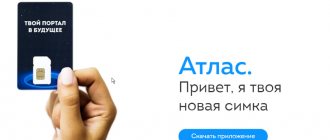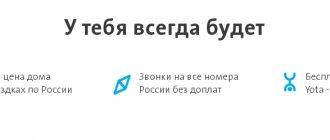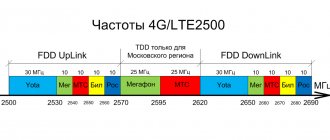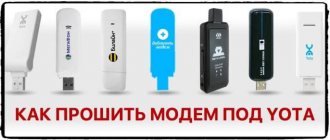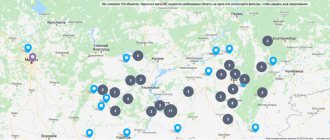From the history
In fact, we can say that Yota is MegaFon.
In 2012, they entered into official cooperation (combined assets), and in 2014, Iota launched as a virtual mobile operator. The coverage areas of the two operators are almost the same, with the exception of a few cities in which MegaFon managed to install LTE Band 20 networks. In such places, Yota does not operate in 4G format. Yota is indeed a subsidiary of MegaFon, but it is not the same thing. Yota retain their specificity and concept of a virtual operator, while using MegaFon equipment. Yota operates from its towers, which it owned before the merger, and from the towers of its parent company. Before this, shares in Yota belonged to Scartel, which was bought by the famous operator.
Yota plans for 4G network
Considering that broadband access to the network is becoming more and more in demand every day, the Iota service segment is increasing, and the operator’s coverage areas with the 4G standard are expanding. The company plans to fully master the LTE radio frequency range that meets the needs of target consumers. It is also possible to switch to innovative technologies if they appear in the future.
Tariffs: basis of choice
Getting to know the operators began as usual with choosing a suitable tariff. In both cases, tariffs are presented in the form of package offers that provide a certain set of minutes, gigabytes and additional features.
To begin with, we decided to consider the most budget options, setting all the settings to the minimum, we got the following values:
- Iota - 250 minutes and 1 gigabyte of Internet for 250 rubles. Messages are charged separately, and you don’t have to think about unlimited applications.
- Megafon - 400 minutes, 6 gigabytes, 100 SMS, unlimited Viber, WhatsApp and eMotion for 300 rubles.
Cities with high quality Iota network
As studies have shown, the close location of the tower does not always allow you to receive a high level of Internet signal from Yota. The Yota LTE reception area depends on weather conditions, the location of the base station, and the signal level. According to observations, network reception in St. Petersburg is much better than in Moscow and the Moscow region. There are several cities where the Internet reception is best:
- Krasnodar;
- Kursk;
- Astrakhan;
- Sochi;
- Tyumen;
- Vladimir;
- Tomsk;
- Voronezh;
- Yaroslavl;
- Saratov;
- Orenburg;
- Ufa;
- Magnitogorsk;
- Ivanovo;
- Tver.
Iota’s 4G coverage area is also present in Izhevsk, Yekaterinburg, Kazan, Naberezhnye Chelny, Cheboksary and Bryansk.
Is Iota MegaFon or something else?
There is a fairly widespread opinion that Yota and MegaFon are the same operator. Legally, they are the same, but practically, they perform different functions. MegaFon is considered a traditional mobile operator. Yota, in turn, plays the role of a virtual operator, one of the main vectors of which is the provision of unlimited Internet.
MegaFon and Yota have the same coverage area, but different tariffs. The answer to the question of which of them is better is very difficult. It depends on what the subscriber himself expects from the tariff plan. For example, Yota provides absolutely unlimited traffic for accessing the Internet from a computer (unlike MegaFon). The quality of voice calls is basically the same for both operators.
More about Yota: Yota tariffs in the Tula region and Tula – TarifBerry
MegaFon is great for those who value high-quality voice calls and high-speed Internet on their smartphone. A series of “Turn On” tariff plans have been developed especially for this category of subscribers, which can satisfy any needs.
How the band system works
Bands are specifications for 4G frequency bands. There are a total of 70 bands covering 4g LTE frequencies from 450 to 2600 MHz, but only 5 are used in Russia:
- B3 (1800 MHz FDD);
- B7 (2600 MHz FDD);
- B20 (800 MHz FDD);
- B31 (450 MHz FDD);
- B38 (2600 MHz TDD).
FDD (Frequency Division Duplex) and TDD (Time Division Duplex) are methods for organizing bidirectional data transmission in the LTE network. FDD is a frequency division of traffic: incoming traffic goes on one frequency, outgoing traffic on another. When using TDD, loading and unloading occur at the same frequency alternately.
From the point of view of mobile operators, TDD technology is more profitable because it allows the use of equipment that supports only one frequency band. FDD is more convenient for the user, since data transmission channels will not interfere with each other and the speed should be higher, especially with a weak signal. But in practice, the difference between FDD and TDD is almost invisible.
Since the data transmission speed in the LTE network depends not only on the frequency, but also on the distance to the base station, the number of communication channels and their width, LTE Advanced technology was developed, which allows the use of several frequency ranges simultaneously. This is called frequency aggregation.
The download speed was raised to 1 Gbit/s, while when using one frequency range it does not exceed 150 Mbit/s. The 4G+ standard places special requirements on the network equipment of the base station and mobile device: they must have the required number of physical antennas (MIMO, Multiple Input Multiple Output). Yota was the first to launch this technology in October 2012, but only a few years later it found widespread use, since at that time modems supporting LTE-A were not on sale.
Most operators divide frequency ranges into incoming and outgoing channels unevenly: for example, Yota and Megafon (this is the same holding) have 40 MHz available throughout Russia in several bands. Of these, 30 MHz is used for downloading and only 10 for uploading. MTS and Beeline use 5 MHz for outgoing traffic in each frequency range, 15 for incoming traffic, so the upload speed is lower than the download speed.
The uniqueness of 4G is that a virtually unlimited number of frequency bands can be used. Due to the high congestion of frequencies from 800 to 2600 MHz, in addition to existing bands, LTE-Unlicensed technology was developed, which allows operation at frequencies above 5 GHz, which do not require licensing from government agencies and are characterized by a low amount of interference. However, no operator has yet used it due to the lack of availability of the corresponding equipment.
What is LTE 1800 and LTE 2600
LTE 2600 is the most popular 4G communication standard in the world. It is used mainly in large cities, since radio waves of this frequency have a relatively low penetrating power and require a large number of base stations, but provide high data transfer rates.
Most of the legacy 2G and 3G networks operate at 1800 MHz, so operators are forced to use it due to lack of channel width at other frequencies. Accordingly, the wider the LTE 1800 channel, the less is left for 2G and 3G. But coupled with the aggregation of 800 MHz and 2600 MHz channels, this makes it possible to achieve a network throughput of 300 Mbit/s even at long distances from the base station.
Mobile applications
Both operators provide convenient and functional solutions. We prepared a review of the proprietary application from Yota earlier. A special feature of Megafon’s service is the presence of a points system, which are awarded depending on communication costs. However, in order to fully appreciate the advantages of their use, they can only be assessed after several months of stable use.
Both applications allow you to:
- Top up your balance;
- Track your balance;
- Change the tariff and find out your own number.
Points of sale and technical support
The communication with operators began with the issuance of SIM cards. And the first feature was that on Yota you can order delivery of a SIM card to your home or office. Well, the attempt to justify the status of the first virtual operator is valid. To connect to Megafon, I had to go to a communication store, which, on the other hand, revealed another feature - a Megafon store is much easier to find than Iota.
For the sake of testing communication with technical support, we decided to call both operators on the hotline.
We managed to get to a live operator on Megafon in 4 minutes. A nice girl answered us, who clearly and promptly gave all the information we needed.
It turned out to be more difficult to reach Iota; we managed to contact a technical support specialist only after 12 minutes. The young man answered all our questions clearly and concisely.
However, Yota has another convenient option for communicating with an operator - a built-in chat in the mobile application. We asked a question there and received an answer within a couple of minutes. It's really convenient!
More about Yota: Yota Ussd commands for connecting to a tariff for a tablet and phone: list of active commands
“Turn on! Communicate”
The best option for those subscribers who lead a moderate “mobile” life. The monthly subscription fee is 600 rubles. For this amount we receive 500 minutes of voice traffic in any direction: mobile and landline phones. 12 GB of Internet traffic without restrictions are available, unlimited viewing of mobile television of MegaFon channels, a couple of films from the archive as a bonus.
A pleasant and significant feature is complete unlimited communication on social networks and instant messengers. You can correspond as much as you like on domestic Odnoklassniki and VKontakte, and “not our” Facebook; endlessly send stickers to your friends on Viber, WhatsApp and eMotion. The tariff area is the entire territory of the Russian Federation.
Summing up
Pros:
- Fine-tuning the tariff;
- Convenient connection;
- Mobile application with built-in chat.
Minuses:
- Interruptions in Internet connection (only on the periphery);
- It's quite difficult to reach customer support.
Megaphone
- Stable Internet;
- Excellent level of service in branded salons;
- Multifunctional application;
- Availability of bonus points;
- Prompt technical support.
Minuses
- Expensive tariffs;
- Lack of ability to choose the apps you need for unlimited access.
Signal in different regions of the country
If you look at the Yota coverage area in detail, you can see that in the northern and southern parts of the country the connection is partially present. The operator offers the use of 4G Internet to subscribers living in:
- Murmansk;
- St. Petersburg;
- Krasnodar;
- Sochi;
- Rostov-on-Don.
4G Yota coverage is available in the resort city of Sochi, so vacationers will not be left without a high-quality network connection. In cities of the Far East, as well as nearby areas, subscribers can use voice communications.
In the northwest and central regions, the map shows good levels of 2G connectivity. Only in some areas the network is completely absent. Standard 3G connections are less common; LTE cell phone towers are located mainly in the southern and western districts.
How to view Iota coverage area
All control buttons are located at the top of the map. Determining your location, searching on the map, Yota - MTS - Mega - Tele2 (operator map management), Yandex traffic jams, Map modes (Outline, Satellite, Hybrid, Panoramas), Expand map (on entire page). In the left vertical part there is a scale control slider.
Daily updates allow our visitors to always have the latest and most accurate information about coverage in all cities where Yota and MTS, Megafon and Tele2 operators are present.
When you open the page, 2G-3G-4G network zones are loaded by default. You can disable them by pressing the operator button on the map again.
Yota, MTS, Megafon and Tele2 cards can be superimposed on each other, comparing the availability of the network in the right place in the selected area.
More about Yota: At what frequency does Yota 4G operate and what is the maximum speed of the LTE modem
Why is it important to know the location of the towers?
The company's equipment is located unevenly. Equipment providing 4G communications is located in large cities, while the rest are located in different regions of the Russian Federation. On the coverage map yota.ru/coverage you can see different zones and draw appropriate conclusions.
Knowing which towers Iota operates on and where they are located can be useful in the following cases:
- Connecting to an operator and wanting to clarify coverage for your region of residence.
- Intention to buy a dacha in an ecologically clean area and find out if there is good coverage here.
- Search for missing people when portable base stations may be required.
- Hiking trip to understand which direction to go.
- Installing and configuring the router to determine the correct antenna position.
- Determination of radio interference, which is especially important for radio amateurs.
Of course, the location of such equipment is important to the operator who uses and maintains it.
Now you know whose towers Yota operates on and how to find them. In the comments, share your information about the location of the points and the features of their search.
“Turn on! Speak”
The most limited offer from this series. A subscription fee is charged in the amount of 500 rubles every month. For this you get 600 minutes of voice traffic, 3 GB of Internet for web surfing, downloading files, etc., as well as the ability to communicate unlimitedly in instant messengers. The operator also provides free and unlimited viewing of MegaFon TV, but without a package of channels - you need to buy them separately. Like other variations, TP “Turn on! Speak” operates throughout the Russian Federation and is designed for those who rarely access the Internet.
Internet
As for connecting to the Internet, it is financially and technically advantageous to cooperate with Yota:
- The client pays for speed; there is no limit on data transfer.
- At any time, he can reduce this parameter, extending the paid service for a longer period.
- If the funds run out, he can access the Internet for free at a speed of 64 kbit/sec. The indicator is small, but it is enough to send a message in instant messengers.
The data transfer settings are very subtle and can be changed in the application. The user has the right to choose which services are more preferable to him and to enable separate options for them. For example, unlimited on YouTube, Instagram, Vkontakte. Everything that he does not need can be excluded from the range of services. Conclusion: no one on the market offers better conditions than Iota.
Video about how Yota’s tariff setting system works:
Megafon, like other large communications companies, offers to use the paid limit, which is usually used up before the end of the month. After this, the network is disconnected, and the client is sent an SMS to the number and offered to pay for additional traffic. Iota is better in this regard: when the standard limit is used up, you can still access the Internet at minimum speed while continuing to conduct text correspondence.
The same applies to tariffs with options for unlimited use of any messenger or service. For example, Megafon included unlimited use of YouTube in the tariff for 1,000 rubles per month. For comparison, Yota offers to do the same by connecting the opportunity for 100 rubles.
Yota does not offer other paid services, much less impose anything, like Megafon. Therefore, the risk of becoming a victim of fraudsters is minimal.
Although Megafon has more stable data transmission, since the company has greater network coverage. This is especially noticeable when leaving a populated area. Plus, you need to remember the limitations of a 4-G connection: where a Yota subscriber automatically connects to 3-G, Megafon guarantees full LTE.
“Turn on! Listen"
Rejoice, music lovers - this tariff is especially for those who cannot live without music. For a modest 300 rubles per month, subscribers are provided with 250 minutes of local calls, 6 GB of Internet traffic for any needs, and unlimited communication in instant messengers. And the highlight of the program is unlimited access to listening to music through special services.
The supported services include the most popular portals: VKontakte Music, Yandex.Music, BOOM and Zvooq. Anyone who subscribes to this tariff plan will be able to watch unlimited mobile television with a package of operator channels. Naturally, the tariff is valid in all localities of the country, but long-distance calls are charged separately.
What Yota offers
The operator divides tariff plans into three categories depending on what device the subscriber will work from: mobile phone, tablet computer and modem (or router). There is one tariff available for smartphones, it is very flexible and can be customized to suit your needs. The minimum monthly fee will be 370 rubles per month. This includes: 200 min. in the Russian Federation, two gigabytes of mobile traffic. A more complete package for 5 thousand minutes and thirty gigabytes will cost the subscriber 2850 rubles/month. Additionally, users can connect a variety of options. For example, for just fifty rubles a month you can get the “Unlimited SMS” option. The parameters of tariff plans in Yota are regulated at the discretion of subscribers.
For tablets there is full unlimited use.
You can pay for the service for:
- One day – 50 rub.
- Month – 500 rub.
- Year – 4500 rub.
The longer the payment period the subscriber chooses, the cheaper the service will be. Traffic is not charged. But it is worth considering that Iota introduces one limitation - you cannot download torrents, otherwise the speed will drop to the minimum level.
The operator also has offers for PCs, these are also unlimited tariffs.
